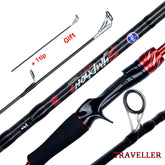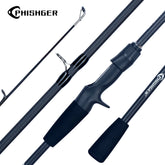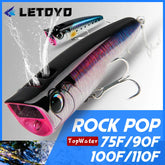Nothing beats a surface blow-up. This guide covers the best times and places to fish topwater lures, how to pick the right bait, and the retrieves that consistently trigger strikes - tested on real water.
Table of contents
- Why topwater works
- Best timing & conditions
- Productive locations
- Choose the right topwater
- Rod, reel & line setup
- Retrieves that get eats
- Common mistakes & quick fixes
- Seasonal quick guide
Why topwater works
- Visibility: Fish can see and hear the disturbance from far away.
- Reaction: Sound + wake force a decision—chase or miss out.
- Coverage: You can cover water quickly and call fish up from depth.
Best timing & conditions
- Low light: Dawn, dusk, and overcast days are prime.
- Wind: Light ripple is great; heavy chop kills cadence. Aim for < ~10 mph.
- Water temp: Consistent from mid-50s °F upward; peak action 60–80 °F.
- Pre-front: Pressure drops often spark aggressive surface feeds.
Productive locations
- Edges: Weed lines, grass mats, pad edges, and shade lines from docks.
- Shallow flats: 1–6 ft near bait; watch for nervous water and wakes.
- Points & pockets: Wind-blown points push bait; calm pockets shelter ambush fish.
- Current breaks: Eddies below riffles or creek mouths on reservoirs and rivers.
Choose the right topwater
| Type | Use when | Action cue |
|---|---|---|
| Walking baits (spooks) | Clear to lightly rippled water; covering water fast | “Walk-the-dog” side-to-side with short twitches |
| Poppers | Targets & tight spots, calm to slight ripple | Pop–pop–pause; let the cup spit then rest |
| Prop baits | Over shallow grass & around wood | Steady buzz or short bursts with brief pauses |
| Frogs | Mats, pads, cheese—anywhere you’d snag other baits | Walk or chug over cover; pause in holes |
Browse our Topwater Lures or start with a ready-to-fish combo.
Rod, reel & line setup
- Rods: Medium to Medium-Heavy with Fast tip for accurate twitches and strong hook-sets.
- Reels: 2000–3000 size spinning or a mid-speed baitcaster; smooth drag matters.
-
Line:
- Walkers & poppers: 10–12 lb mono or 10–15 lb braid + 12 lb mono leader (mono floats).
- Frogs: 30–50 lb braid direct to frog (no stretch, cuts vegetation).
- Hooks & hardware: Keep split rings fresh; upsize one step only if action stays true.
Retrieves that get eats
- Walkers: Rod tip down. Twitch–twitch–twitch with slight slack to keep the bait gliding. Add a 2–3 s pause after a miss.
- Poppers: Two sharp pops, then a long pause. In cold water, extend the pause to 5–10 s.
- Prop baits: Slow, steady buzz around isolated cover; kill it beside the target.
- Frogs: Walk across mats; stop in openings. Wait to feel weight before swinging—don’t set on the splash.
Common mistakes & quick fixes
- Missed strikes: Point the rod at the bait; reel until you feel weight, then sweep hard.
- Short casts: Check spool fill and go thinner line; match lure weight to rod rating.
- Bait won’t walk: Add slack between twitches; downsize leader or shorten to 12–18 in.
- Frog sinks: Squeeze water out periodically; switch to a new frog if it keeps flooding.
Seasonal quick guide
- Spring: Poppers around beds and bluegill spawns; slow cadence.
- Summer: Dawn/dusk walker over points and flats; frogs all day on mats.
- Fall: Chase bait—fast walkers on wind-blown banks and schooling fish.
- Winter (warm spells): Midday windows on sunny, protected banks—tiny poppers with long pauses.
Ready to make ’em look up? See our curated topwater picks or grab a balanced combo so you’re casting smoothly on day one. Use code TACKLEJOY10 for 10% off your first order. Free shipping on $69+ after discount.
Suggested images
- Close-up of a walking bait creating a V-wake at dawn — alt: Topwater walking bait waking across calm water
- Angler working a frog across lily pads — alt: Hollow-body frog over pads
- Popper paused beside dock shade — alt: Topwater popper near dock posts
Tags:










